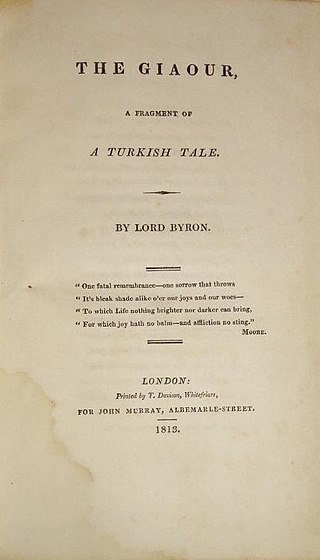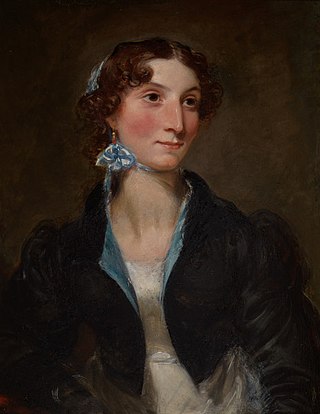
"Ozymandias" is a sonnet written by the English Romantic poet Percy Bysshe Shelley (1792–1822). It was first published in the 11 January 1818 issue of The Examiner of London. The poem was included the following year in Shelley's collection Rosalind and Helen, A Modern Eclogue; with Other Poems, and in a posthumous compilation of his poems published in 1826.

James Henry Leigh Hunt, best known as Leigh Hunt, was an English critic, essayist and poet.
This article contains information about the literary events and publications of 1818.
This article contains information about the literary events and publications of 1817.

Clara Mary Jane Clairmont, or Claire Clairmont as she was commonly known, was the stepsister of the writer Mary Shelley and the mother of Lord Byron's daughter Allegra. She is thought to be the subject of a poem by Percy Bysshe Shelley.

The Giaour is a poem by Lord Byron first published in 1813 by John Murray and printed by Thomas Davison. It was the first in the series of Byron's Oriental romances. The Giaour proved to be a great success when published, consolidating Byron's reputation critically and commercially.
Nationality words link to articles with information on the nation's poetry or literature.

George Gordon Byron, 6th Baron Byron, known simply as Lord Byron, was an English romantic poet and peer. He was one of the leading figures of the Romantic movement, and has been regarded as among the greatest of English poets. Among his best-known works are the lengthy narratives Don Juan and Childe Harold's Pilgrimage; many of his shorter lyrics in Hebrew Melodies also became popular.
Henry M. Milner was a 19th-century British playwright and author of melodramas and popular tragedies. Milner wrote numerous plays, including two popular equestrian dramas/hippodramas featuring live horses on stage. These are: Mazeppa; or, the Wild Horse of Tartary, which kicked off a wave of interest in the legend and Dick Turpin's Ride to York; or, Bonny black Bess, about the famous highwayman and his horse. Both of these plays included great spectacle in performance and enjoyed great popular success during the mid to late nineteenth century. ' 'Mazeppa' ' was extremely popular and often produced; it is recalled as one of, if not the most, significant and popular equestrian drama of all time.

Frankenstein; or, The Modern Prometheus is an 1818 novel written by English author Mary Shelley. Frankenstein tells the story of Victor Frankenstein, a young scientist who creates a sapient creature in an unorthodox scientific experiment. Shelley started writing the story when she was 18, and the first edition was published anonymously in London on 1 January 1818, when she was 20. Her name first appeared in the second edition, which was published in Paris in 1821.

Percy Bysshe Shelley was one of the major English Romantic poets. A radical in his poetry as well as in his political and social views, Shelley did not achieve fame during his lifetime, but recognition of his achievements in poetry grew steadily following his death and he became an important influence on subsequent generations of poets including Robert Browning, Algernon Charles Swinburne, Thomas Hardy, and W. B. Yeats. American literary critic Harold Bloom describes him as "a superb craftsman, a lyric poet without rival, and surely one of the most advanced sceptical intellects ever to write a poem."

Thomas Medwin was an early 19th-century English writer, poet and translator. He is known chiefly for his biography of his cousin, Percy Bysshe Shelley, and for published recollections of his friend, Lord Byron.

The Bride of Abydos is a poem written by Lord Byron in 1813. One of his earlier works, The Bride of Abydos is considered to be one of his "Heroic Poems", along with The Giaour, Lara, The Siege of Corinth, The Corsair and Parisina. These poems contributed to his poetic fame at the time in England.
Isaac Pocock was an English dramatist and painter of portraits and historical subjects. He wrote melodramas, farces and light operatic comedies, many being stage adaptations of existing novels. Of his 40 or so works, the most successful was Hit and Miss (1810), a musical farce. The mariner Sir Isaac Pocock (1751–1810) was his uncle.
Jeanie Deans is a play written by Dion Boucicault based on Sir Walter Scott's 1818 novel, The Heart of Midlothian. It is named after the heroine of the novel, Jeanie Deans.
English writer Lord Byron has been mentioned in numerous media. A few examples of his appearances in literature, film, music, television and theatre are listed below.

Byron's Memoirs, written between 1818 and 1821 but never published and destroyed soon after his death, recounted at full-length his life, loves and opinions. He gave the manuscript to the poet Thomas Moore, who in turn sold it to John Murray with the intention that it should eventually be published. On Lord Byron's death in 1824, Moore, Murray, John Cam Hobhouse, and other friends who were concerned for his reputation gathered together and burned the original manuscript and the only known copy of it, in what has been called the greatest literary crime in history.
Scrope Berdmore Davies (1782–1852), often given incorrectly as Scrope Beardmore Davies, was an English dandy of the Regency period. He is known as a friend of Lord Byron, the dedicatee of Byron's poem Parisina. He is the subject of a 1981 biography.

Charlotte Mardyn was an English actress of Irish descent of the early 19th-century who was rumoured to have been the mistress of Lord Byron.

William Fisher Peach Dimond was a playwright of the early 19th-century who wrote about thirty works for the theatre, including plays, operas, musical entertainments and melodramas.











